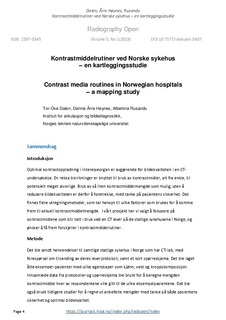| dc.contributor.author | Dalen, Tor-Ove | |
| dc.contributor.author | Årre Høynes, Dennis | |
| dc.contributor.author | Rusandu, Albertina | |
| dc.date.accessioned | 2020-01-21T12:33:25Z | |
| dc.date.available | 2020-01-21T12:33:25Z | |
| dc.date.created | 2019-12-17T22:49:34Z | |
| dc.date.issued | 2019 | |
| dc.identifier.citation | Radiography Open. 2019, 5 (1), . | nb_NO |
| dc.identifier.issn | 2387-3345 | |
| dc.identifier.uri | http://hdl.handle.net/11250/2637241 | |
| dc.description.abstract | Introduction
Optimal contrast enhancement in the organ of interest is crucial for the image quality of a CT examination. Potential side effects of contrast media range from mild to potentially severe. The use of the smallest possible amount, without compromising the image quality, is therefore preferable considering patient safety. Different methods of calculations, that consider different factors, are used to calculate the relevant amount. Our project focuses on the contrast media used in a "CT liver" examination among the public hospitals in Norway, and we wish to present the differences in contrast media routines.
Methods
Inquiries were sent to every public hospital that have a CT-lab in Norway, asking for their liver protocol, also including a short questionnaire. Eight example patients with different characteristics (sex, weight and body composition) were created. Information from the protocols and the questionnaires were used to calculate the amount of contrast media each of the hospitals would give to each example patient. Previous studies were used to calculate the recommended amounts of contrast media based on patient safety and optimal image quality.
Results
Calculations show differences between 66% and 117% (from lowest to highest amount) of contrast media given to the example patients. Out of the 30 participating hospitals, 6 use software, 17 use weight tables, 2 use fixed amounts and 5 use weight tables that takes body composition into consideration as their methods of calculating the amount of contrast media. None would have given more than the recommended amounts, considering patient safety, while between 6,7% and 36,7% would have given less than the recommended amounts, considering image quality.
Conclusion
The results show significant differences in contrast media usage among Norwegian hospitals. In conclusion, there is room for improvement and standardization of contrast media routines. Optimization of contrast media routines will benefit both patient safety, image quality and cost. | nb_NO |
| dc.language.iso | nob | nb_NO |
| dc.publisher | Høgskolen i Oslo og Akershus | nb_NO |
| dc.rights | Navngivelse 4.0 Internasjonal | * |
| dc.rights.uri | http://creativecommons.org/licenses/by/4.0/deed.no | * |
| dc.title | Kontrastmiddelrutiner ved norske sykehus–en kartleggingsstudie | nb_NO |
| dc.type | Journal article | nb_NO |
| dc.type | Peer reviewed | nb_NO |
| dc.description.version | publishedVersion | nb_NO |
| dc.source.pagenumber | 24 | nb_NO |
| dc.source.volume | 5 | nb_NO |
| dc.source.journal | Radiography Open | nb_NO |
| dc.source.issue | 1 | nb_NO |
| dc.identifier.doi | 10.7577/radopen.3607 | |
| dc.identifier.cristin | 1762244 | |
| dc.description.localcode | Copyright (c) 2019 Tor Høye Dalen, Dennis Årre Høynes , Albertina Rusandu Creative Commons License This work is licensed under a Creative Commons Attribution 4.0 International License. | nb_NO |
| cristin.unitcode | 194,65,25,0 | |
| cristin.unitname | Institutt for sirkulasjon og bildediagnostikk | |
| cristin.ispublished | true | |
| cristin.fulltext | original | |
| cristin.qualitycode | 1 | |

